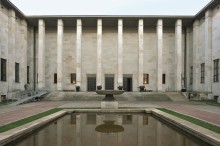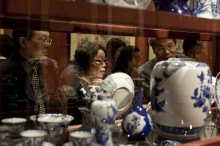National Museum in Warsaw, Poland

 The National Museum in Warsaw was originally founded in 1862 as the Museum of Fine Arts and is currently one of the oldest art museums in the country.
After Poland regained its independence in 1918, the National Museum was ascribed a prominent role in the plans for the new state and its capital city of Warsaw, and the Modernist building in which it currently resides was erected in 1927–1938. Today, the National Museum in Warsaw boasts a collection numbering around 830,000 works of art from Poland and abroad, from ancient times to the present including paintings, sculptures, drawings, prints, photographs, coins, as well as utilitarian objects and design.
The National Museum's collection of Far and Middle Eastern art existed from the outset and has developed together with the institution. Initially part of the general ethnographic department, it was divided in the 1930s between the Decorative Arts Collection and the Print Collection. After World War II a separate Department of Middle and Far Eastern Art was created within the Decorative Art Gallery and, finally, an independent Department of Asian Art was established in 1971.
It is now known as the Oriental Art Collection and with its approximately 8,000 art objects, acquired mostly as gifts and purchases, is the second largest in Poland after the National Museum in Krakow. It consists mainly of Chinese and Japanese pottery and woodcuts, and also contains a rich and varied set of paintings, sculptures in wood and stone, objects of bronze, lacquer, ivory, enamel, and textiles. The prewar collection suffered considerably during the bombardment of the building in 1939. During the war many valuable pieces were lost and never recovered.
The Department of Oriental Art Collection is divided into the following sections: Chinese Art Collection (the largest in Poland), Japanese Art Collection, Islamic Art Collection and Buddhist and Hindu Art Collection.
The Chinese Art Collection groups some 5,000 objects, mostly dating from the 17th to 19th c. Among them is a significant group of ceramics, also jade, stone and wood sculpture, textiles and lacquer ware, as well as. Metals include a large set of Qianlong period bronzes and cloisonné enamels, as well as painted enamels. Traditional painting is represented by over two hundred scrolls, album leaves and albums. Some 800 New Year and other folk woodblock prints from across China form an interesting and valuable group.
The Japanese Art Collection, one of the largest collections in Poland, contains more than 2,000 objects. It includes paintings, sculptures, ukiyo-e and shin hanga prints, ceramics, cloisonné enamels, metal works, lacquer and ivory works from Edo, Meiji, Taisho and Showa periods. Of particular value are tsuba sword guards, netsuke and okimono, lacquer ware, cloisonné enamels, imari porcelain and satsuma wares.
Islamic art is represented by over 1000 objects: manuscripts and miniature painting, textiles, pottery and glass, objects of metal, wood, leather and stone objects. The extensive pottery collection comprises a representative selection of Arabic, Persian and Turkish wares (8th to 17th c.)
The Buddhist and Hindu Art Collection comprises around 600 objects, of which the most important are: bronze figurines of gods and deities, 18th-20th c. religious scroll-paintings (thang-ka), stone and wood sculpture, sacred Buddhist manuscripts from South, South-East and Inner Asia.
A number of temporary collections on Asian art have also been organised at the National Museum, including Beyond the Great Wall. Chinese Art from the Collection of the National Museum in Warsaw (2013). In addition, the National Museum collaborates with other museums abroad - an example of this is the exhibition Orientalism in Polish Art, presented at the Pera Museum of the Suna and Inan Kiraç Foundation in Istanbul (2014/15).
The National Museum in Warsaw was originally founded in 1862 as the Museum of Fine Arts and is currently one of the oldest art museums in the country.
After Poland regained its independence in 1918, the National Museum was ascribed a prominent role in the plans for the new state and its capital city of Warsaw, and the Modernist building in which it currently resides was erected in 1927–1938. Today, the National Museum in Warsaw boasts a collection numbering around 830,000 works of art from Poland and abroad, from ancient times to the present including paintings, sculptures, drawings, prints, photographs, coins, as well as utilitarian objects and design.
The National Museum's collection of Far and Middle Eastern art existed from the outset and has developed together with the institution. Initially part of the general ethnographic department, it was divided in the 1930s between the Decorative Arts Collection and the Print Collection. After World War II a separate Department of Middle and Far Eastern Art was created within the Decorative Art Gallery and, finally, an independent Department of Asian Art was established in 1971.
It is now known as the Oriental Art Collection and with its approximately 8,000 art objects, acquired mostly as gifts and purchases, is the second largest in Poland after the National Museum in Krakow. It consists mainly of Chinese and Japanese pottery and woodcuts, and also contains a rich and varied set of paintings, sculptures in wood and stone, objects of bronze, lacquer, ivory, enamel, and textiles. The prewar collection suffered considerably during the bombardment of the building in 1939. During the war many valuable pieces were lost and never recovered.
The Department of Oriental Art Collection is divided into the following sections: Chinese Art Collection (the largest in Poland), Japanese Art Collection, Islamic Art Collection and Buddhist and Hindu Art Collection.
The Chinese Art Collection groups some 5,000 objects, mostly dating from the 17th to 19th c. Among them is a significant group of ceramics, also jade, stone and wood sculpture, textiles and lacquer ware, as well as. Metals include a large set of Qianlong period bronzes and cloisonné enamels, as well as painted enamels. Traditional painting is represented by over two hundred scrolls, album leaves and albums. Some 800 New Year and other folk woodblock prints from across China form an interesting and valuable group.
The Japanese Art Collection, one of the largest collections in Poland, contains more than 2,000 objects. It includes paintings, sculptures, ukiyo-e and shin hanga prints, ceramics, cloisonné enamels, metal works, lacquer and ivory works from Edo, Meiji, Taisho and Showa periods. Of particular value are tsuba sword guards, netsuke and okimono, lacquer ware, cloisonné enamels, imari porcelain and satsuma wares.
Islamic art is represented by over 1000 objects: manuscripts and miniature painting, textiles, pottery and glass, objects of metal, wood, leather and stone objects. The extensive pottery collection comprises a representative selection of Arabic, Persian and Turkish wares (8th to 17th c.)
The Buddhist and Hindu Art Collection comprises around 600 objects, of which the most important are: bronze figurines of gods and deities, 18th-20th c. religious scroll-paintings (thang-ka), stone and wood sculpture, sacred Buddhist manuscripts from South, South-East and Inner Asia.
A number of temporary collections on Asian art have also been organised at the National Museum, including Beyond the Great Wall. Chinese Art from the Collection of the National Museum in Warsaw (2013). In addition, the National Museum collaborates with other museums abroad - an example of this is the exhibition Orientalism in Polish Art, presented at the Pera Museum of the Suna and Inan Kiraç Foundation in Istanbul (2014/15).
View all Asia-Europe Museum Network (ASEMUS) members in Poland
Similar content
posted on
28 Mar 2012
posted on
25 Mar 2012
posted on
01 Jul 2012
from - to
17 Dec 2011 - 03 Jun 2012
02 Oct 2015
posted on
03 Feb 2012
